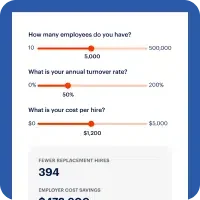As one of the largest generational groups in U.S. history enters retirement age and beyond, caregivers are more in demand than ever. In order to keep up with the growing need, health facilities are reexamining the way they recruit and retain employees.
What does turnover look like in the caregiving industry and how are recruiting and retention practices evolving?
Understand the effects turnover has on the healthcare industry and reduce it.
The Outlook of the Caregivers Industry
Caregivers in home health, assisted living, retirement communities, skilled nursing facilities and rehab centers make up the industry the Bureau of Labor classifies as home health and personal care aides.
Between 2016 and 2026, the Bureau of Labor Statistics (BLS) estimates that the home health and personal aide industry will grow 41%, which is much faster than average. (For context, a 7% growth rate is about average for all industries in the U.S.)
The industry growth is a product of two factors:
- As the baby-boomer population ages — and the elderly population grows — the demand for the services of home health aides and personal care aides will continue to increase
- Turnover rates in the industry are higher than average at many facilities
A recent podcast that featured our CEO Jason Lee, and Chuck Schmitz, CFO of senior living facility Christian Horizons, discussed turnover rates in the caregiving industry — specifically at elder care facilities. Schmitz said many senior care facilities experience turnover rates of approximately 70% each year, with some organizations battling upwards of 90% turnover each year.
Why is Staffing an Issue for Caregivers?
The staffing issues at caregiving facilities are a result of several factors.
First, caregivers face tough workplace demands on both physical and emotional levels. The exhaustion of the profession causes a high level of burnout, which translates to turnover.
The next issue comes down to dollars and cents. The median pay in the home health and personal aide category is about $27,510 per year or $13.23 per hour per hour. Home health employees may look to another job with comparable wages if it has less emotional and physical strain.
Lastly, it’s a tight labor market out there, which means there are more job openings than available workers. As such, there is more competition to land qualified staff, meaning HR and recruiting departments need to be more creative than ever when attracting new talent.
The Cost of Turnover in the Caregiving Industry
Labor gaps and high turnover rates are bottom line killers for any organization.
Industry analysts estimate that replacing one skilled employee can cost a facility $2500 or more in recruiting and training costs which can be broken into segments such as the following:
- Pre-departure disengagement
- Recruiting to fill a position
- Selection for new hire
- Orientation and training
- Productivity loss for all staff
Senior care facilities can easily find themselves in a catch-22. To grow their business they need new residents and patients at their facilities. But in order to maintain high patient levels, they need staff to keep operations running smoothly. Facilities with high turnover rates may also face reputational challenges – families want reliable care for their loved ones. Each of these factors plays a role in the true cost of turnover at a caregiving facility.
Pressure to Raise Wages is Growing
Maintaining healthy staff levels and profit margins (in any industry) is often viewed at as a wage and benefits conversation. The theory being, high wages can increase recruiting numbers, differentiate yourself from competitors, and potentially help retain staff.
Koelsch Senior Living Communities, in Bozeman, Montana, was recently forced to raise wages to attract new employees. Dan Williams, COO of Koelsch Senior Living Communities said, “We’re competing with a car wash. We’re competing with fast food in that town. We’re competing with retail in that town. Those kind of pressures will force your hand into doing things that 10 years ago we didn’t have to.”
Koelsch specifically pointed to a car wash in town that started paying new employees $15 an hour—well above Montana’s state minimum wage of $8.30, and higher than the industry’s national wage average of $13.23.
The problem is, even if wage increases feel like a natural solution, many facilities cannot afford the adjustments.
Finding Affordable Leverage in a Tight Labor Market
Daily pay benefits are a unique way to differentiate yourself in a tight labor market.
Daily pay benefits give your employees more control over when and how they receive their pay. As soon as a caregiving in your facility works a shift, theoretically he or she could withdraw their earned but unpaid pay.
Daily pay benefits are designed to help alleviate financial burdens that may affect employees at caregiving facilities, and also empower smarter financial strategies.
Providing instant access to pay has proven a viable (and affordable) benefit for many organizations, too. Not only are daily pay solutions non-disruptive to your current payroll process, companies who offer on-demand pay:
- Fill open positions 52% faster than organizations who don’t offer an instant payroll benefit
- Experience an average of 41% reduction in attrition
And, daily pay is a financial perk.













